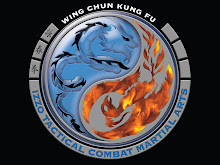If there is something that I agree with in the fighting word that holds true linking Wing Chun and MMA is that 99.9% of all fights end up on the ground.
My first intro to Wing Chun was as an inquisitive wrestler. I searched for years for a martial art that suited me, and I was giving up hope. From my personal view, I was more comfortable in grappling distance and other martial arts could not deal with the close range combat. This was proven true with the initial years of MMA and the Gracie family.
I tried Boxing and Shotokan Karate and although the two are phenomenal forms of combat, they were not for me.
I attended a Law Enforcement seminar (I was a police officer from 2001 through 2008) and met with my first Wing Chun Kung Fu instructor Danny Halligan.
After the seminar I spoke with Halligan and expressed to him my interest in Martial Arts and my disatisfaction in the realm of the realistic nature most arts lacked. I told Danny Halligan that my main concern was the take-down factor and I wondered if Wing Chun was able to "deal" with grapplers.
Halligan invited me (very respectfully) to take him down...I was not able. Every single time I shot or attempted to close the gap between Halligan and I, he beat me to it...He closed the gap first... He "attacked" me at the moment I advanced on him. I was baffled at how Wing Chun did not retreat or gain space in order to judge how to deal with a threat, rather Wing Chun crowded me as I advanced.
What was also noticeable was the fact that as I was trying to position myself to grab Halligan on his legs, hips or wrists, he was continually hitting me on the head, neck, and sternum. He litteraly was attacking me while I was trying to control him.
The issue of footwork and Wing Chun is that it lies completely on balance. In Wing Chun the goal of our strike is to hit as powerfully as we can, take the enemy's balance and keep your balance. Balance is paramount!
This starts with the concept that balance is natural. Think of when we walk. We walk with our head over our hips, and over our feet. If we lean forward, taking our head off of the line of joints, we become off balance. So we adopt this in the "rear leg" concept of Wing Chun balance.
Balance is also a personal issue. Since Sifus cannot be experience the internal side of their students I strongly suggest working on the self discovery of balance over and over and over. It took me YEARS to find my balance and two Sifus with conflicting retrospect.
My first Sifu adopted the traditional Wing Chun 90% of the weight on the back leg stance. Now, although I fully endorse this training as to break the "front leg heavy" American sport mindset, I cannot endorse this for combat.
When your weight is on the back leg, your entire foot is flat on the ground. You can take a straight line and drive it through the top of your head, through your hip and out your foot. Balance this way DOES allow you to root energy into the ground, however for unskilled fighters, it will prove un-effective for practical fighting. In other words, yes, if a MMA guy shot in on you, you are already headed on the ground.
After years of personal research and reading, I must say that I support Wong Shun Leung's concept that balance is 50/50...with a focus on the rear leg.
When kicking or moving forward, it only takes 51/49 or 1% of weight distribution change in order to do so.
Instead of our entire foot being on the ground, we focus on our instep and heel. Keep in mind that shifting and staying rooted in the ground is/are a dynamic movement. By that I mean we shift side to side, but depending upon the circumstance, we also angle down or up...depending how we attack or maintain balance. I.E. the Lap Sau. When you Lap Sau are you simply pulling the arm across, or are you pulling it across and down? Just questions to explore.
Shifting also makes use of the adductors inside the legs. We use these for sharp, powerful movements as well as to "put the brakes on" when shifting in shorter movements. Shifting is dynamic...and thus should be thoroughly explored.
Think of a patio table we use in the summer. The table is round with the umbrella driven right through the center...we turn the table and the umbrella is still center. This is reflective of our centerline position as far as a core concept rather than the facing concept.
The same holds true with the 50 /50 stance. Our head and centerline is always directly over both feet.
Try shifting your Wing Chun stance in both manors. You will notice that when you shift in the 90 / 10 stance, your head and centerline move over the respected foot. In the 50 / 50 stance, your centerline does not change.
Again, this is a personal preference and what has worked for me. I have very flat feet and walk on my instep.
It was my Wing Chun Kung Fu brother Dan who helped me find balance over the years. His ecouragement was to constantly "discover" my Wing Chun... and I feel I have.
Do 99.9% of all fights end up on the ground? Sure, if you don't know how to fight on your feet.
Dominick Izzo
Self Defense Advocate / Self Defense Instructor
www.izzo-training.com
Chicago Area Wing Chun Self Defense

